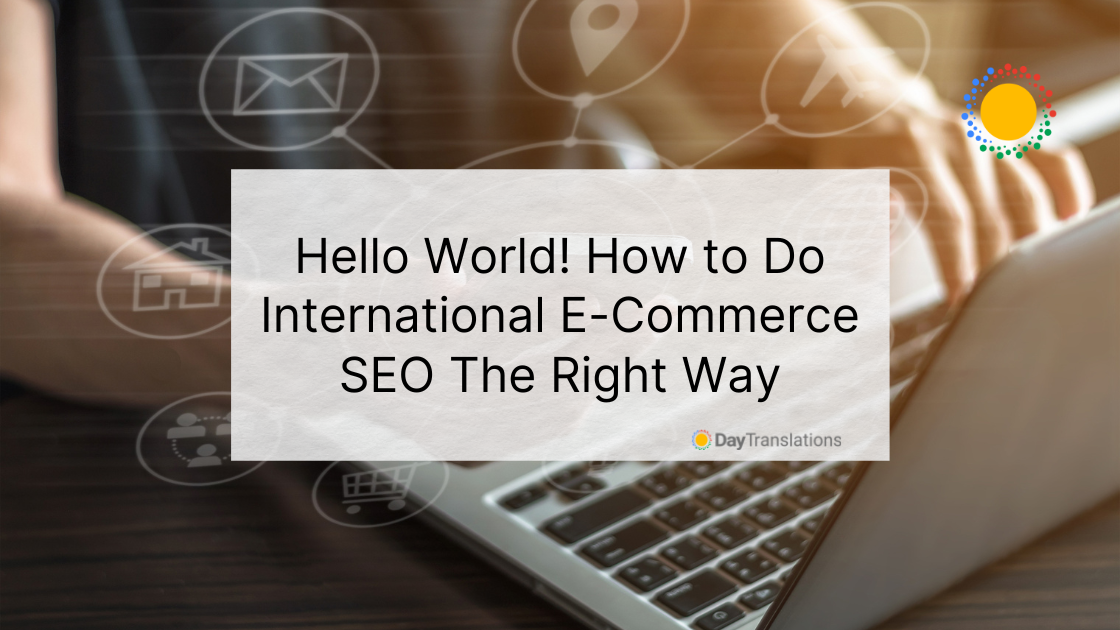2020 and 2021 brought unprecedented growth for the e-commerce sector. But those that ignored e-Commerce SEO might not have bathed in this glory of growth. This digital shift took place at an international scale, and it was especially felt in developing economies, where growth is expected to continue in the next couple of years. For example, Statista Digital Market Outlook forecasts that e-Commerce sales in LATAM will reach 160 billion dollars in 2025.
If you’re planning to expand your online store beyond borders, this is probably the right time. But international expansion isn’t just about translating your site or creating a social media presence in your target audience’s language. These are important steps, but e-Commerce expansion goes far beyond that. It’s a strategically demanding process that involves several marketing sub-disciplines working together, to increase your visibility and help you engage with your new audience.
In this post, we’ll take a look at international SEO for e-Commerce.
We’ll discuss:
- What is international e-Commerce SEO
- Why international SEO is an important part of your strategy
- Actionable steps to succeed at international SEO
Let’s dive in.
What Is International e-Commerce SEO?
Before we get started, it’s worth taking a look at what international SEO is.
SEO (Search Engine Optimization) is a discipline that aims to get your site to organically rank on Google through technical, design, and content best practices.
But, what does it mean to rank on Google organically? To rank on Google organically is to appear on the first page of the Google search results, without paying for an ad.
SEO is a cost-efficient discipline, which usually comes with tons of benefits beyond ranking on Google. For instance, there’s an overlap between SEO & UX. So, a site that implements SEO best practices is usually also compliant with UX and accessibility standards.
But, how is “international SEO” different from regular SEO? To understand international SEO, we first need to take a look at local SEO.
Google detects where users are geographically, and tailors search results so they meet their specific needs. In some cases, the user will explicitly demand location-specific results, by using terms such as “near me” in their search query. But even when it’s not the case, Google will target your results so they’re relevant for you, wherever you are.
Considering that Google “thinks” locally, when you’re targeting a new international market, you should implement a new SEO strategy to make your site relevant in that new location. That’s what we mean by “international SEO”. Doing SEO internationally is just doing local SEO overseas. Additionally, international SEO focuses on how to articulate your different local websites, to maximize your outreach across the globe.
When it comes to an online store, your international e-Commerce SEO strategy will cover many fronts. Including:
- Which keywords to target to compete with locals
- How to guarantee good site speed for mobile users in that target locale
- General e-commerce localization (currency use, payment gateway integrations, and more)
Let’s take a look at an example.
How e-Commerce SEO Impacts your Expansion Strategy
Needless to say, the cornerstone of a successful international SEO strategy is localization. Your website has to be adapted to your audience’s target language and preferences. But beyond localizing your content for usability and accessibility, you’ll need to localize it to rank for relevant keywords.
For instance, let’s say you run a clothing store, and you’re expanding to Mexico. Instead of targeting a keyword such as “silk shirts for women”, you’ll need to target “camisas de seda para mujer”. With this in mind, your international SEO strategy should be in the hands of a team that speaks your target audience’s language.
Additionally, if you’re running a company blog, you’ll want to create content that’s designed to attract your new target audience. But, how can you make it possible? Simple, through queries that are specifically relevant in their country. But beyond targeting keywords, you’ll also want to reflect their specific needs in your content.
For example, let’s say that you’re also expanding to Chile. In December, it’s summer in the Southern Hemisphere, so your Chilean customers won’t be cold during the holidays. Consequently, if you’re creating a guide on how to dress for Christmas Eve, you’ll want to recommend light summer dresses instead of coats. And maybe, your special holiday offers should focus on summer clothes, rather than winter coats.
Creating targeted content beyond keywords will:
- Make your website more shareable
- Prevent your users from bouncing off, after finding your content frustrating and irrelevant
- Help you create value-driven customer experiences
- Facilitate sales
An SEO strategy helps you increase your visibility, understand your customers, and tailor your site to meet their needs. There’s far more to SEO than just keywords. For instance, in the case of our example, where should the localized online store for Chile or Mexico be hosted? Should it be a subdirectory of the main website, or should it be a completely different website with its own top-level domain?
We’ll explore this question in the next section, and we’ll share 5 international SEO tips that will help you succeed.
5 Key Tips to Succeed at International e-Commerce SEO
Wondering where to get started with your international SEO strategy?
Make sure to:
- Choose your domain wisely
- Implement Hreflang tags
- Create language selectors and splash pages
- Know your audience
- Establish relationships with local creators & get quality backlinks
Choose your Domain Wisely
Your localized website and your “original” website will have a lot in common, but they’ll be two different online presences, targeting two different audiences. Therefore, you may be wondering if you should use the same domain, or choose an entirely different domain.
There are 5 options you should take a look at:
- Using your original domain gTLD (generic top-level domain) with language parameters – mywebsite.com?es-mx
- Using a unique ccTLD (country code top-level domain) for each new website – mywebsite.mx
- Hosting your localized sites in subdirectories – mywebsite.com/mx
- Creating a subdomain for each localized store – mx.mywebsite.com
- Creating a gTLD for each new store – mywebsitemexico.com
All options have their pros and cons. For instance, if you choose to use your original gTLD with language parameters, you’ll need to keep an eye on your code, as your codebase will include all your localizations with little separation between them. This option also comes with some SEO downsides. For example, you’ll be diluting your capacity to compete in specific target markets.
This option does have some benefits. For instance, it has lower maintenance costs than its alternatives, as you’re using your site’s existing architecture, and building on it. Additionally, it can help you concentrate your domain authority, by taking all your traffic and backlinks to your main domain.
Subdirectories
If you choose to host your localized stores in subdirectories, you’ll experience the same pros and cons you’d experience with language parameters.
Unique ccTLD
If you use a unique ccTLD, you’ll be giving search engines clear signals of what they need to rank, and how to rank it. This is probably the best option to rank for local searches, and it also gives you flexibility to manage your presence in each target market differently. Using a unique ccTLD may be a great option if, for example, you’re targeting the Chinese market, which has very different functional, technological, and language needs.
The downsides of this approach have to do with cost and domain authority. Managing different websites demands more resources. And, by setting up a different site for each locale, you’re fragmenting your online presence. This prevents your main site from getting the domain authority it’d get if you concentrated all your traffic there.
gTLD
If you choose to create a gTLD for every localized version of your store, you’ll come across the same issues that are caused by using a unique ccTLD. Basically, you’ll need to build domain authority for your localized site, from scratch. Additionally, you’ll face high localization and maintenance costs.
While ccTLDs can be “connected” in the eyes of Google, so the search engine understands that they belong to the same brand, that’s not the case for gTLDs. So, your gTLDs may end up competing against each other for keywords. Basically, you may end up “cannibalizing” your site.
Implement Hreflang Tags
Hreflang tags are a type of metatag. They help Google bots to decide which version of your site corresponds with each language. You can find them on your source code, your site map, and your HTTP header.
Implementing hreflang tags is as simple as adding a code snippet to your header:
<link rel=”alternate” hreflang=”[ISO language code]” href=”[Localized URL]“/>
Use Language Selectors & Splash Pages
Some websites will provide users with a linguistically appropriate experience by detecting their browser’s language. Some websites will do so by detecting where the user is located.
Both methods are fallible. So it’s a good practice to offer your users a language selector or splash page, which will allow them to choose which version of your site they want to browse.
Know your Audience
As we mentioned previously, SEO isn’t just about keywords and meta tags. SEO is about understanding your audience and crafting a strategy to connect with them in a meaningful and competitive way. So, one of our SEO recommendations (which is also a localization tip), is to learn as much as you can about your audience.
Before you start investing in localization, you should assess whether there’s a market gap in your target locale that you can fulfill. You should know who’s your audience, what are their (unmet) needs, and which trends are relevant to them. There’s no technical trick or research tool that can make up for lacking this type of insight.
Be as client & user-oriented as possible, and use your qualitative research to inform and optimize your SEO strategy.
Create Relevant Backlinks for your Target Markets
Finally, it’s worth mentioning that backlinks are one of Google’s strongest ranking factors. Google’s ranking criterion is very similar to how authority works in academia. Basically, the more cited a research paper is, the more reputable and influential it is. In the case of Google, when a website has thousands of backlinks, the search engine assumes that its content is trustworthy and valuable, so it will favor it in search results.
A great way to start building that rapport in your new target locales is connecting with local creators that are relevant to your target audience. Incorporating Shopify development services can further enhance your e-commerce platform’s functionality and user experience, making it more appealing to international markets. Partnering up with creators won’t just give you backlinks, it will also help you connect with potential customers. So, this helps you raise your E-commerce business, whether it is E-commerce in Australia or somewhere else.
As we mentioned in the introduction, SEO best practices are usually PR, design, and accessibility best practices. Great SEO is more than just SEO. So having a search engine optimization strategy can be a catalyst to grow beyond Google search result pages.
Start your e-Commerce Localization Journey Today
Discover Day Translations ’Localization & Global SEO Services
Article by Clay Kramer
Clay Kramer is the CEO of SEORadar. SEORadar is an SEO disaster prevention tool trusted by thousands of companies, including teams at Shopify, GoDaddy, Booking.com, and Zillow.












Sorry, the comment form is closed at this time.